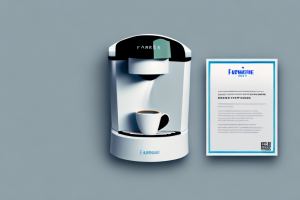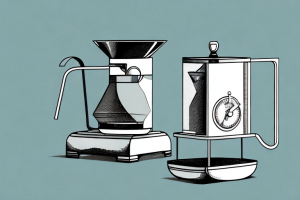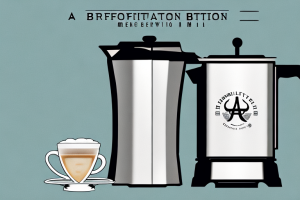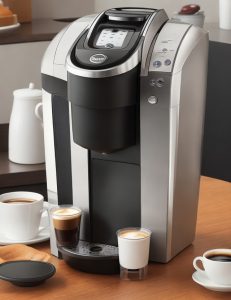Coffee Maker Water Line

A coffee maker connected to a water line
If you’re a coffee lover, you know that the quality of your coffee can greatly depend on the quality of the water used to brew it. This is where the coffee maker water line comes in. In this article, we’ll explore why the water line is important for your coffee maker, understand how it works, types of water lines available, installation, common problems, maintenance tips and upgrading options. Strap in for the ultimate guide on coffee maker water lines.
Why the water line is important for your coffee maker
The water line is the key component in ensuring your coffee maker consistently brews high-quality coffee. By using a direct water line, the machine can automatically refill and maintain a constant level of water in the reservoir, giving you a consistent cup of coffee every time. This is essential for commercial coffee makers, where large volumes are required. However, it is also ideal for home use because you no longer have to remember to refill the water tank manually, and hence it gives you peace of mind and time to focus on other important things in your life.
Another advantage of using a water line in your coffee maker is that it reduces the risk of contamination. When you manually refill the water tank, there is a chance that you may introduce impurities or bacteria into the water, which can affect the taste and quality of your coffee. With a direct water line, the water is filtered and purified before it enters the machine, ensuring that your coffee is always clean and fresh.
Furthermore, using a water line can also save you money in the long run. While it may require an initial investment to install the line, you will no longer need to purchase and replace water filters or constantly buy bottled water to refill the tank. This can add up to significant savings over time, especially if you are a heavy coffee drinker or own a commercial coffee maker.
Understanding how the water line works in your coffee maker
A coffee maker water line is a simple but effective device that connects to your mains water supply. The line is fitted with a safety valve that automatically shuts off the water supply if the pressure becomes too high. It also allows you to adjust the water pressure to regulate the rate at which water flows into your coffee maker. The line is fitted with an inlet valve that opens and closes to control the water’s flow and prevent leaks. Once the water reaches the coffee maker’s reservoir, it is heated and used to brew your coffee.
It is important to regularly clean and maintain your coffee maker water line to ensure it functions properly. Over time, mineral deposits and other debris can build up in the line, causing blockages and reducing water flow. To clean the line, simply disconnect it from the coffee maker and flush it out with a mixture of water and vinegar. This will help to remove any buildup and keep your coffee maker running smoothly.
Types of water lines for coffee makers
There are two main types of water lines for coffee makers. The first type is a push-to-connect line that connects directly to the coffee maker’s inlet. These are easy to install and ideal for home use. The second type is a braided steel water line that can handle higher pressure and is ideal for commercial coffee makers.
It is important to note that the type of water line you choose for your coffee maker can affect the taste of your coffee. If you are using a push-to-connect line, it is recommended to use a filter to remove any impurities in the water. On the other hand, braided steel water lines are less likely to affect the taste of your coffee due to their durability and resistance to corrosion.
Installing a water line in your coffee maker
Before installing your water line, you’ll need to ensure that the coffee maker is unplugged and that all the components are clean to avoid contamination. Start by selecting the right type and size of water line for your coffee maker. Follow the manufacturer’s instructions to connect the water line directly to the coffee maker’s inlet. Once the line is connected, turn on the water supply and slowly increase the pressure until the coffee maker’s reservoir is filled. Then, turn on the coffee maker, and voila – you have a direct water line connection!
It’s important to note that installing a water line in your coffee maker may void the manufacturer’s warranty. Be sure to check your warranty information before proceeding with the installation. Additionally, if you’re not comfortable with plumbing or electrical work, it’s best to hire a professional to install the water line for you.
Having a direct water line connection to your coffee maker can save time and hassle, as you won’t need to constantly refill the reservoir. However, it’s important to regularly clean and maintain the water line to prevent buildup and ensure the quality of your coffee. Refer to the manufacturer’s instructions for proper cleaning and maintenance procedures.
Common problems with coffee maker water lines and how to fix them
One of the most common problems with coffee maker water lines is the buildup of mineral deposits in the line. This can lead to clogging, leaks and even damage to the coffee maker. To solve this problem, regularly flush your water line with vinegar or a descaling solution to remove any buildup. Another common issue is blockages caused by debris in the line. In this case, you’ll need to remove and clean the line or replace it if it’s damaged.
Another issue that can arise with coffee maker water lines is the growth of mold and bacteria. This can happen if the water line is not properly cleaned and dried after each use. To prevent this, make sure to thoroughly clean and dry the water line and reservoir after each use. You can also use a solution of water and vinegar to disinfect the water line.
In some cases, the water line may become disconnected or loose, causing leaks or a loss of water pressure. To fix this, check the connections and make sure they are tight and secure. If the water line is damaged or worn, it may need to be replaced. It’s important to address any issues with the water line as soon as possible to prevent further damage to the coffee maker and ensure a consistent flow of water for brewing.
Maintenance tips for your coffee maker water line
The best way to prevent problems with your coffee maker water line is by regular maintenance and cleaning. To start, always use clean tap water to minimize mineral buildup. Follow the manufacturer’s instructions for cleaning and maintenance to ensure that your water line has the longest lifespan possible. If you notice any leaks or inconsistent water pressure, troubleshoot the problem immediately to avoid damage to your coffee maker.
Another important maintenance tip is to descale your coffee maker regularly. Over time, mineral buildup can clog the water line and affect the taste of your coffee. To descale, mix equal parts of water and white vinegar and run the solution through your coffee maker. Rinse thoroughly with clean water before using it again.
It’s also a good idea to replace the water filter in your coffee maker every few months. This will help remove impurities and improve the taste of your coffee. Check your coffee maker’s manual to see if it has a built-in water filter or if you need to purchase one separately.
Upgrading your coffee maker with a new water line system
If you’re serious about coffee and want the best brewing experience, consider upgrading your coffee maker with a new water line system. Many coffee makers offer the option of a direct water line connection, allowing you to enjoy a hassle-free brewing experience. Before upgrading, research different brands and models to find the best one for your needs and budget.
One of the main benefits of upgrading your coffee maker with a new water line system is the convenience it provides. With a direct water line connection, you no longer have to worry about constantly refilling the water reservoir or running out of water mid-brew. This is especially useful for offices or households with multiple coffee drinkers. Additionally, a water line system can improve the taste of your coffee by ensuring a consistent water flow and temperature. Overall, investing in a water line system can greatly enhance your coffee brewing experience.
The benefits of using a water line in your coffee maker
There are several benefits to using a water line in your coffee maker, including consistent water supply and pressure, hassle-free brewing, and peace of mind that you’ll always have fresh coffee when you need it. Additionally, using a water line eliminates the need for manual refilling, which saves you time and ensures a steady supply of coffee.
Another benefit of using a water line in your coffee maker is that it reduces the risk of contamination. When you manually refill your coffee maker with water, there is a chance that you may introduce impurities or bacteria into the water, which can affect the taste and quality of your coffee. However, with a water line, the water is filtered and purified before it enters the coffee maker, ensuring that your coffee is always clean and delicious.
Comparing different brands and models of coffee makers with water lines
There are several coffee makers with water lines on the market, each with its unique features and benefits. Before purchasing, consider factors such as price, capacity, brewing options, and ease of use. Research different brands and models to find the one that best suits your needs and budget. Some popular brands include BUNN, Curtis, and Technivorm.
That wraps up our ultimate guide to coffee maker water lines. We hope you now have all the information you need to make an informed decision when choosing a coffee maker with a water line, maintaining and upgrading it to enhance your brewing experience. Happy brewing!
When it comes to capacity, it’s important to consider how much coffee you typically brew at once. If you’re a heavy coffee drinker or often entertain guests, a larger capacity coffee maker may be more suitable for your needs. However, if you only brew a cup or two at a time, a smaller capacity coffee maker may be more practical and cost-effective.
Another factor to consider is the brewing options available. Some coffee makers with water lines offer multiple brewing options, such as hot water dispensers or the ability to brew iced coffee. If you enjoy experimenting with different brewing methods, a coffee maker with more options may be worth the investment.



